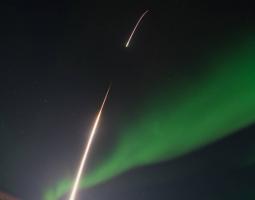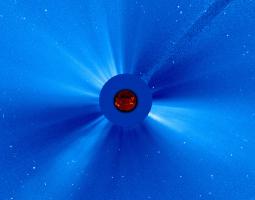Sounding Rockets
For over 40 years the Sounding Rocket Program has provided critical scientific, technical, and educational contributions to the nation's space program and is one of the most robust, versatile, and cost-effective flight programs at NASA.
Sounding rockets carry scientific instruments into space along a parabolic trajectory. Their overall time in space is brief, typically 5-20 minutes, and at lower vehicle speeds for a well-placed scientific experiment. The short time and low vehicle speeds are more than adequate -- in some cases they are ideal -- to carry out a successful scientific experiments. Indeed, there are certain important regions of space that are too low for satellites and thus sounding rockets provide the only platforms that can carry out measurements in these regions.
Sounding rockets can be an attractive alternative to orbital missions as they do not need expensive boosters or extended telemetry and tracking coverage since they never go into orbit. As a result, mission costs are substantially less than those required for orbital missions. The sounding rocket program takes advantage of a high degree of commonality and in many cases, only the experiment -- provided by the scientist -- is changed. In some cases, such as almost all astronomy, planetary, solar, and microgravity missions, the payloads are recovered, which means the costs of the experiment and sub-systems are spread out over many missions.
Not only are sounding rocket missions carried out at very low cost, but also the payload can be developed in a very short time frame -- sometimes as quickly as 3 months. This rapid response enables scientists to react quickly to new phenomena (such as observing the Shoemaker-Levy comet impact to Jupiter) and to incorporate the latest, most up-to-date technology in their experiments.
The sounding rocket program continues to serve as a low-cost testbed for new scientific techniques, scientific instrumentation, and spacecraft technology, eventually flown on numerous satellite missions. For example, COBE, CGRO, EVUE, FAST, ASTRO-2, UARS, SOHO, TRACE, and numerous other recent NASA satellite missions have been enabled by technology and techniques developed in the suborbital program. Furthermore, the low cost of sounding rocket access to space fosters innovation: instruments and/or technologies which are not sufficiently developed to warrant the investment of satellite-program scale funding are often proto-typed with initial space testing on sounding rockets.
In addition to science and technology, sounding rockets also provide invaluable tools for education and training. For example, a three-year sounding rocket mission at a university provides an excellent research opportunity for a Ph.D. dissertation, in which the student carries the project through all of its stages -- from conception to hardware design to flight to data analysis and, finally, to publication of the results. This hands-on approach provides the student with invaluable experience of understanding the space flight mission as a whole. Over 350 Ph.D.'s have been awarded as part of NASA's sounding rocket program
A heliophysics sounding rocket launches into an aurora in the early morning of March 3, 2014, over Venetie, Alaska. The Ground-to-Rocket Electrodynamics – Electron Correlative Experiment, or GREECE, mission studied how certain structures – classic curls like swirls of cream in coffee -- form in the aurora.
Credit: NASA/Christopher Perry






